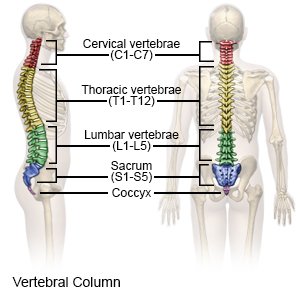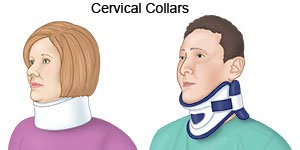Cervical Radiculopathy
Medically reviewed by Drugs.com. Last updated on Aug 4, 2025.
What is cervical radiculopathy?
Cervical radiculopathy is a painful condition that happens when a spinal nerve in your neck is pinched or irritated.
 |
What causes cervical radiculopathy?
Changes in the vertebrae (bones) and discs in your neck can put pressure on a spinal nerve. Discs are natural, spongy cushions between your vertebrae that allow your spine to move. The following can cause a pinched nerve:
- Disc damage may occur if a disc flattens, bulges, or moves over time. An injury can also cause disc damage.
- Cervical spondylosis is when the vertebrae in your neck break down. This normally occurs as you age.
- Growths , such as tumors or cysts (fluid-filled lumps), may grow and press on the nerve.
What are the signs and symptoms of cervical radiculopathy?
The most common symptom is sharp pain that travels from your neck all the way down your arm. You may have pain in your shoulder, chest, and hand. The pain may get worse with movement or when you cough or sneeze. You may also have any of the following:
- Burning or tingling sensations in your neck or arm
- Numbness or weakness in your arm or hand that makes it hard for you to grip objects
- Headaches
Related medications
How is cervical radiculopathy diagnosed?
Your healthcare provider will ask when and how your symptoms began. Your provider will gently press on your neck to check for tenderness and areas that are not shaped correctly. Your provider will also check your arms and hands for numbness or weakness. You may have any of the following:
- Provocative tests are done to check your response to certain movements. Your provider will ask you to move your neck, shoulder, and arm in different ways. Some movements will increase your symptoms, while others will make you feel better.
- An x-ray is a picture of the bones and tissues in your neck.
- An MRI or a CT scan may be used to take pictures of your neck. The pictures can show problems and changes in your nerves, discs, and vertebrae. You may be given contrast liquid to help the pictures show up better. Tell the provider if you have ever had an allergic reaction to contrast liquid. Do not enter the MRI room with anything metal. Metal can cause serious injury. Tell the provider if you have any metal in or on your body.
- An electromyography is also called an EMG. An EMG is done to test the function of your muscles and the nerves that control them. Electrodes (wires) are placed on the muscle being tested. Needles may be attached to the electrodes and placed in your skin. The electrical activity of your muscles and nerves is measured by a machine attached to the electrodes. Your muscles are tested at rest and during movement.
How is cervical radiculopathy treated?
- NSAIDs decrease swelling and pain. This medicine can be bought without a doctor's order. This medicine can cause stomach bleeding or kidney problems in certain people. If you take blood thinner medicine, always ask your provider if NSAIDs are safe for you. Always read the medicine label and follow the directions on it before using this medicine.
- Prescription pain medicine may be given to decrease pain. Do not wait until the pain is severe before you take this medicine.
- Steroids help decrease pain and swelling. These may be given as a pill or as an injection in your neck. You may need more than 1 injection if your symptoms do not improve after the first treatment.
- Physical therapy helps stretch and strengthen your muscles. Your physical therapist can teach you how to improve your posture and the way you hold your neck. The therapist may also teach you how to be safely active and avoid further injury. The therapist can also help you develop an exercise program that is safe for your back and neck.
- Surgery may be used to treat a pinched nerve if other treatments have not helped after 6 to 12 weeks.
Treatment options
The following list of medications are related to or used in the treatment of this condition.
How can I manage my symptoms?
- Ice helps decrease swelling and pain. Ice may also help prevent tissue damage. Use an ice pack, or put crushed ice in a plastic bag. Cover it with a towel and place it on your neck for 15 to 20 minutes every hour or as directed.
- Rest when you feel it is needed. Slowly start to do more each day. Return to your daily activities as directed.
- Wear a soft collar. You may be given a soft collar to support your neck while you sleep. Wear the soft collar only as directed.

- Do light stretches and regular exercise. Your provider may suggest light stretches to help decrease stiffness in your neck and arm as you recover. After your pain is controlled, you may benefit from regular exercise. Ask what type of exercise is safe for your back and neck.
- Review your work area. A comfortable work area can help prevent neck strain. Ask your employer for an ergonomic review to check the position of your desk, chair, phone, and computer. Make any necessary adjustments for your comfort.
When should I contact my healthcare provider?
- You are losing weight without trying.
- Your pain is worse, even with medicine.
- One or both hands feel more numb than before, or you cannot move your fingers well.
- You have questions or concerns about your condition or care.
Care Agreement
You have the right to help plan your care. Learn about your health condition and how it may be treated. Discuss treatment options with your healthcare providers to decide what care you want to receive. You always have the right to refuse treatment. The above information is an educational aid only. It is not intended as medical advice for individual conditions or treatments. Talk to your doctor, nurse or pharmacist before following any medical regimen to see if it is safe and effective for you.© Copyright Merative 2025 Information is for End User's use only and may not be sold, redistributed or otherwise used for commercial purposes.
Learn more about Cervical Radiculopathy
Treatment options
Care guides
Further information
Always consult your healthcare provider to ensure the information displayed on this page applies to your personal circumstances.
